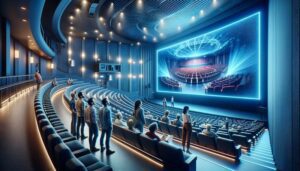
In an increasingly connected world, the film industry finds itself at a unique crossroads, with the opportunity to reflect and celebrate the diversity that surrounds us. CMRA Consulting Services, known for its innovative approach in providing services to the film industry, plays a crucial role in this cultural shift, helping cinemas and producers navigate and embrace the growing demand for more inclusive representation on screen. In 2024, this commitment to diversity is not only broadening cinema’s horizons but also enriching the viewer’s experience in ways previously unimaginable.
The Importance of Diversity in Cinema
Diversity in cinema transcends mere representation; it’s a matter of justice and equity, giving voice to stories and perspectives that have long been marginalized. Including diverse viewpoints not only enriches the narrative fabric of cinema but also authentically reflects the world we live in. In this context, CMRA Consulting Services positions itself as a strategic ally for those in the industry eager to make a difference, offering services that facilitate the creation and distribution of content that truly represents the diversity of our society.

The film industry has undergone significant evolution in the last decade, marked by technological advancements that have transformed not only how movies are produced but also how they are experienced in cinemas. As we move into 2024, various developments in cinematic screen technology have emerged, promising to further enrich the viewing experience for a global audience.
One of the most notable advances in cinematic screens is the widespread adoption of laser projection technology. This type of projection offers a significantly wider color range, deeper blacks, and greater brightness compared to traditional projection technologies. The projected images are so vivid and detailed that they almost leap off the screen, providing an unprecedented immersion into cinematic narratives.
High Dynamic Range (HDR) screens have taken image quality to new levels, allowing for more accurate representation of light and shadow. This technology significantly enhances contrast and allows colors to be displayed with greater accuracy, resulting in images that more realistically reflect the filmmaker’s original intention. HDR screens are particularly effective for scenes with extreme variations in light, providing clarity and image depth that was hard to achieve previously.
The development and installation of giant LED screens in cinemas represent another significant advancement. Unlike traditional projection screens, LED screens generate their own light, which eliminates the need for projectors and allows for consistent image quality across the entire screen. These screens offer significant advantages in terms of brightness and reliability and can operate in a range of ambient lighting conditions, making them ideal for a variety of cinematic spaces.
Expanded screen formats, such as IMAX and Dolby Cinema, continue to evolve, offering viewers even more immersive visual experiences. These formats not only focus on increasing the size of the screen but also on enhancing the quality of the image and sound to create a fully immersive cinematic experience. The technology behind these formats has been refined to include improvements in projection and the screen itself, ensuring that each scene is presented with the utmost fidelity.

Innovation in 3D viewing has led to the development of glasses-free 3D screen technology, marking a significant shift in how 3D movies are experienced. Through advanced lenticular and parallax barrier techniques, these screens allow viewers to enjoy three-dimensional effects without the need for special glasses, eliminating one of the major drawbacks of previous 3D projections and making the experience more comfortable and accessible.
As we look towards the future, it’s clear that advances in cinematic screen technology will continue to be a key area of innovation in the film industry. These technologies not only improve the quality of the visual experience for viewers but also open new avenues for filmmakers in terms of visual narrative and production design. With the support of companies like CMRA Consulting Services, which facilitate the adoption of these advanced technologies, cinema is well-positioned to continue its evolution, offering increasingly rich and immersive experiences that engage and delight audiences around the world.
CMRA Consulting Services stands out for its personalized approach and deep understanding of current market dynamics. Through the implementation of targeted marketing strategies and optimization of movie selection, CMRA helps its clients stand out in a competitive market. Its commitment to promoting diversity is reflected in the choice of projects they support, ensuring that each story told contributes to a more inclusive and varied cinematic landscape.
Diversity on screen is not just a matter of representation; it’s a means to enrich the cinematic experience for everyone. Today’s audiences seek to see their own lives and cultures reflected in the stories being told, a demand that CMRA Consulting Services fully understands and embraces. By working with cinemas to present diverse programming, CMRA is not only helping to expand the horizons of what cinema can be but also ensuring that every viewer feels seen and valued.

Advancements in cinema screen technologies have been exponential, particularly with the adoption of laser projections and high-definition LED screens, significantly enhancing the visual quality of cinematic experiences. As we delve into 2024, these innovations continue to push the boundaries of what is possible in visual storytelling. However, this trajectory of innovation is not without its challenges, while also anticipating an exciting and transformative future for movie theaters.






